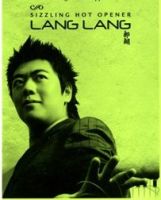
Who Sizzled Anyway?
Pianist Lang Lang headlined the Cincinnati Symphony Orchestra’s sold-out “Sizzling
Hot” gala Thursday night at Music Hall.

What really sizzled, however, were Paavo Järvi and the CSO in a “Made in America” program featuring music by Leonard Bernstein (1980 Divertimento, Symphonic Dances from “West Side Story,” “Candide” Overture).
The Chinese superstar generates heat simply by being himself, the first classical artist in history to perform for an audience of billions (at the 2008 Olympic Games in Beijing) and an unrivaled media phenomenon.
His marketable image – young (27), dashing, spiky-haired – and his reputation as a pyrotechnical wizard assured that the event would be “hot” before he played a note.
However, adjectives like “sizzling” do not comfortably fit Beethoven’s Piano Concerto No. 2 (actually the composer’s first piano concerto, a classically conceived work in the manner of Haydn and Mozart).
Lang Lang was attentive to this. In fact – at least for this listener -- he bent too far in the opposite direction. Though his performance had lyricism and grace, it also had a “precious” quality that lacked Beethovenian sparkle.
All the notes were there, and quite pretty ones, too, but they were sometimes drawn out to excess, especially in the Adagio. The closing Rondo, with its lively syncopated theme, fared better, but seemed weighted, too, by Lang Lang’s overly romantic conception.
The Concerto was more of a piece with Lang Lang’s encore, a gently rendered “Aeolian Harp” Etude by Chopin (Op. 25, No. 1).
The audience, which awarded him a standing ovation, could indulge lavishly in the visual element that is key to Lang Lang’s contemporary appeal. To enhance that, the CSO projected images of him onto a large screen above the orchestra. Every facial expression, every gesture of his hands (often seen in close-ups shot from above) could be tracked by anyone, anywhere in the hall.
This apparent revival of the CSO’s video screen project – scrapped in 1992 after a single concert – is to be lauded. But Thursday’s experiment went a bit too far. Better to place the screen -- or screens, as was done in 1992 when one was mounted on each side on the proscenium arch -- so that they do not impinge on the music. As it was, the images were inescapably “in your face” (and kind of washed-out at that).
There was a truth-in-packaging issue with this concert, too. "Sizzling hot” with Lang Lang would have fit Rachmaninoff, Prokofiev or Tchaikovsky much better.
Järvi and the CSO
fulfilled the temperature requirement with their Bernstein, which was both "sizzlingly hot" and satisfyingly "cool."
Järvi, who has recorded the Divertimento and Symphonic Dances with the City of Birmingham Orchestra (Virgin Classics, 1998) obviously relishes this music and packaged it with zest for the CSO audience.
Commissioned by the Boston Symphony for its 1980 centennial, Bernstein’s Divertimento is a delicious piece of pastiche. What a master he was at taking kernels of repertoire and making them quintessentially Bernstein. There was jazzed-up Mahler, an irregular waltz a la Tchaikovsky’s Sixth Symphony, a Turkey Trot, the Blues and even 12-tone segments that did not sound like it (Bernstein never embraced serial composition). Johann Strauss’ “Radetzky March” got the treatment, also, and it ended with a salute to the BSO recalling Sousa’s “Stars and Stripes Forever.”
The Symphonic
Dances from “West Side Story” is Bernstein-on-Bernstein, drawing from his 1957
Broadway smash to create a lavish, richly colored symphonic tapestry. Opening with the (literally) finger-snapping “Jet
Song,” the eight-part work includes “Somewhere,” dance music from the scene at
the gym (with shouts of “mambo” by the CSO), an arch little “Maria” tinged with
flutes and a "Cool-Fugue” movement given Technicolor
effect by Järvi and CSO. (Bernstein’s
master-touch here is the tangled harmonies that distinguish the
return of “Somewhere” at the end.)
Järvi opened the concert with Copland's "Fanfare for the Common Man" (commissioned and premiered by the CSO in 1942) and closed with a brisk (!), exuberant Overture to “Candide,” itself a departure from ordinary concert routine, where overtures invariably open the program.
The evening set a precedent for the CSO, which has never opened its season with a stand-alone, i.e. non-subscription, gala. Packaged with it were a pre-concert dinner and a post-concert “Afterburn” party in the Music Hall Ballroom with champagne, desserts and dancing. Lang Lang signed innumerable CDs at intermission (and presumably after the concert as well), there were fire eaters on Elm Street outside Music Hall and Japanese kodo drumming in the lobby anticipating the CSO’s tour of Japan in October.
With this rare sell-out concert -- a genuine accomplishment in 3,516-seat Music Hall -- the Cincinnati Symphony's 115th season has gotten off to an exhilarating start.